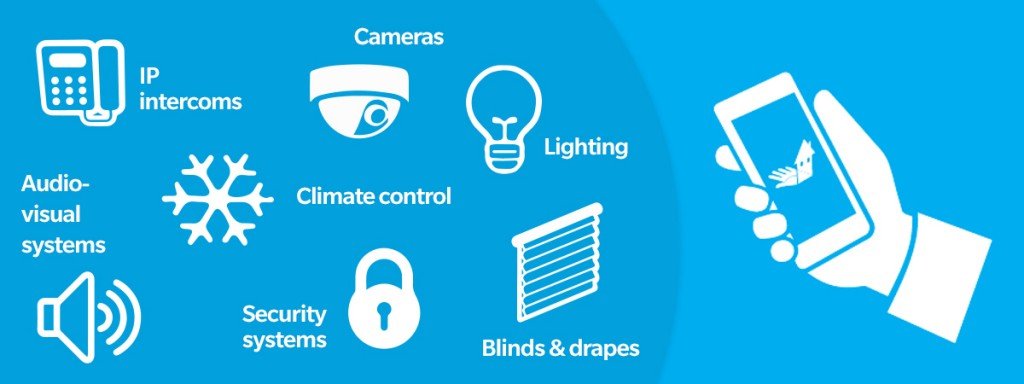Using intelligent switches and control points you can easily control lighting, blinds and every electrical system, in order to make your life easier and much more comfortable.
Through automated events and smart scenarios configuration, our smart home systems save precious time and provide ease of use.
Our systems are designed to respond automatically to changing situations – depending on the time of day and according to number of people at the house.
A typical Smart Home system includes:
1. Lighting Control
Life begins with light. Lighting control systems are used to maximise energy conservation, comply with building codes, green building and energy conservation programs. Often referred to as Smart Lighting.
The major advantage of a lighting control system over stand-alone lighting controls or conventional manual switching is the ability to control individual lights or groups of lights from a single user interface device.
This allows to create various light scenes or scenarios. A room may have multiple scenes pre-set, each one created for different activities in the room.
A major benefit of lighting control systems is energy conservation. Longer lamp life is also gained when dimming and switching off lights when not in use. In a typical installation, lighting can be controlled from – Smart Wall Switches, Elegant Touch Screens, Motion Detectors, mobile devices (Android / iOS), Voice control by Alexa / Google Home and even from Security Systems (for example, Arming a security system can be made to turn off the lights or keep some lights at desired brightness level).
2. Blind Control
Various motorised blinds can be automated and integrated with the Smart Home System.
Blind control can be done manually as well as from various parameters such as daylight, room temperature etc. Integrating blind control with the Smart Home system contributes significantly to energy conservation.
The blinds can be made to move according to the daylight to let in optimum sunlight into the room. We can control the blinds from Wall Switches, Touch Screens, Mobile devices, Voice Control or even as part of a predefined scene / scenario.
3. Climate Control
Smart Home System can have climate control controlling air conditioning, and fans as per the comfort level of the residents.
Control can be exerted from Wall Switches, Touch Screens, Mobile devices, Voice Control or even as part of a predefined scene / scenario.
4. Smart Appliances
Smart home appliances are rapidly capturing the home appliances market. If we aspire to use home appliances from manufacturers of our choice, we need to make sure that they integrate well with our Smart Home System. This is possible only if our Smart Home System is standardised and not dependent on any brand / proprietary protocols.
KNX is the only global standard for Home and Building Automation. A KNX based Smart Home System can accommodate devices from different manufacturers and is a total future proof system. For example, Miele appliances (shown in the image) have embedded KNX functionality.
5. Audio Visual Control
Our system allows shared music and TV, wired or via Bluetooth with built-in speakers for a clean, professional sound and appearance.
Store your remote controls, you will not need them any more! Control all your entertainment systems with just one interface with your smart tablet or phone.
Controlling the audio video components is done with a customised interface tailored to your unique needs.
Control all your home entertainment devices – all from one attractive and intuitive interface.
6. Security & Access Control Systems
A security alarm is a system designed to detect intrusion. Security alarms are used in residential, commercial, industrial, and military properties for protection against burglary or property damage, as well as personal protection against intruders.
The system includes keypad consoles, motion sensors, door reed switches, access control card reader, access key tags etc.
7. Intercom System
A intercom system is used to manage calls made at the entrance to a building (residential complex, detached family home, workplace, etc.) with access controlled by audiovisual communication between the inside and outside. The main feature of video door entry is that it enables the person indoors to identify the visitor and, if they allow, engage in conversation and/or open the door to allow access to the person calling.
8. CCTV
Surveillance cameras can be used to monitor indoor / outdoor areas of a house as decided by the resident. There is a recording system to keep periodic record of the surveillance videos.
9 . Controlled from the palm of your hand!
With SyncWise, you really do hold your home or office in the palm of your hand.










